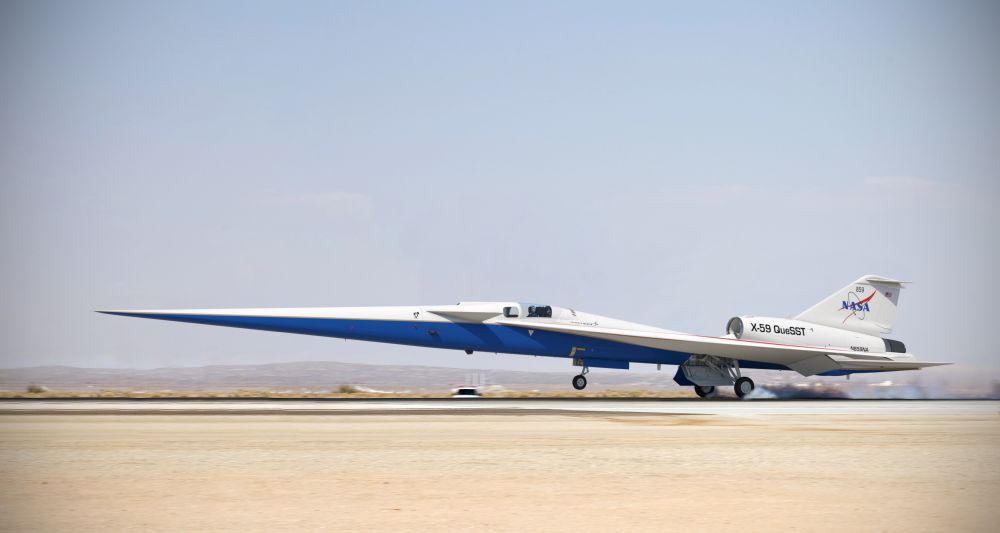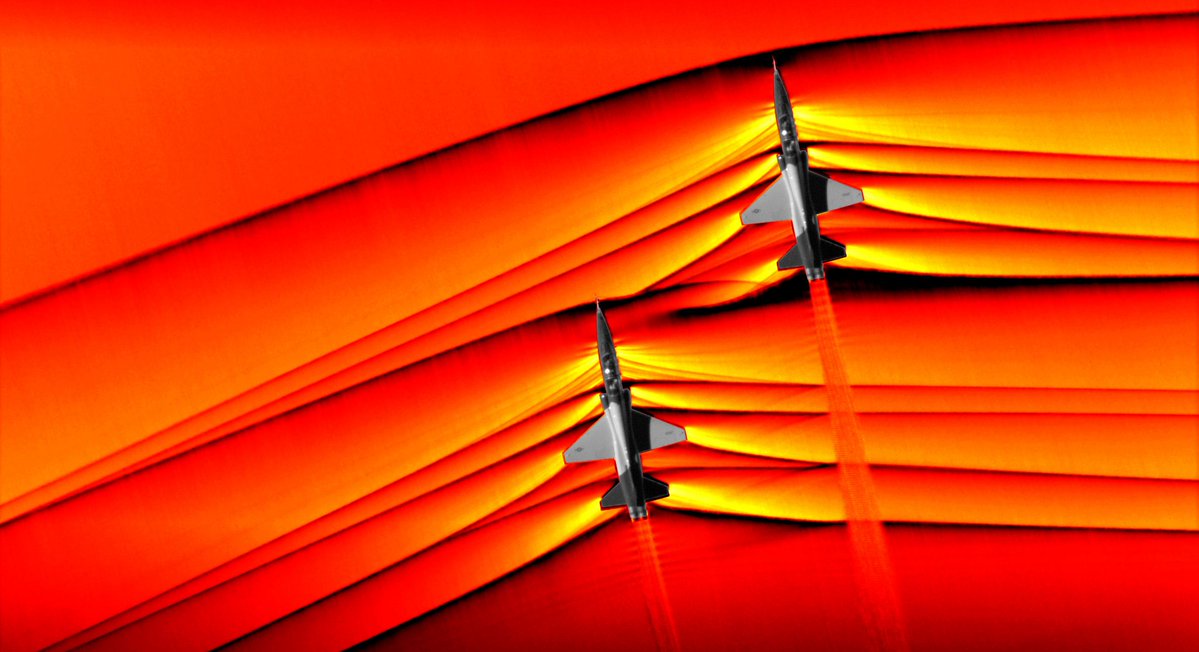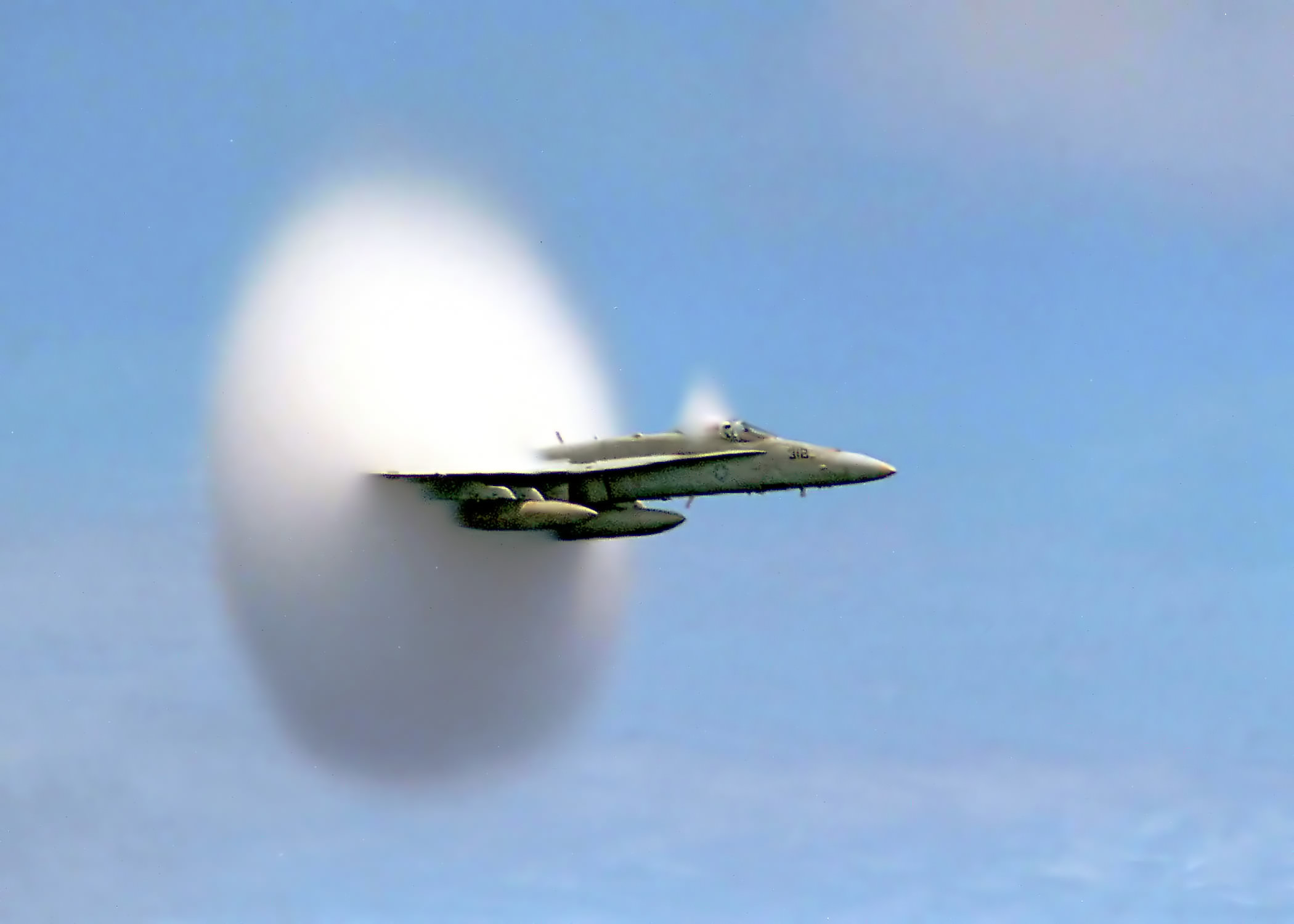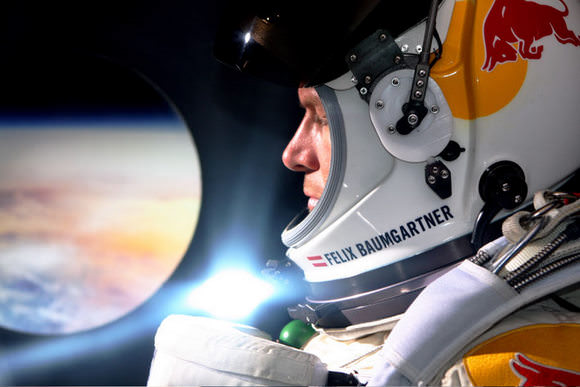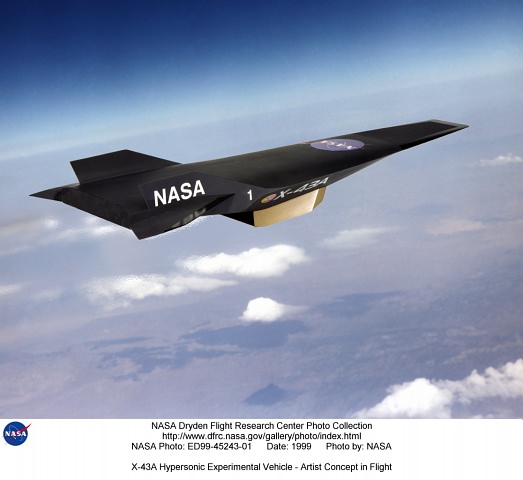NASA’s X-Plane Program has been around for 70 years. Over the course of those decades, the agency has developed a series of airplanes and rockets to test out various technologies and design advances. Now NASA has cleared the newest one, the X-59, for final assembly.
Continue reading “NASA Will Be Building a Quiet, Supersonic Aircraft: the X-59”This is an Actual Photograph of the Shock Waves from Supersonic Jets Interacting with Each Other
After more than 10 years of hard work, NASA has reached another milestone. We’re accustomed to NASA reaching milestones, but this one’s a little different. This one’s all about a type of photography that captures images of the flow of fluids.
Continue reading “This is an Actual Photograph of the Shock Waves from Supersonic Jets Interacting with Each Other”How Fast is Mach One?
Within the realm of physics, there are certain barriers that human beings have come to recognize. The most well-known is the speed of light, the maximum speed at which all conventional matter and all forms of information in the Universe can travel. This is a barrier that humanity may never be able to push past, mainly because doing so violate one of the most fundamental laws of physics – Einstein’s Theory of General Relativity.
But what about the speed of sound? This is another barrier in physics, but one which humanity has been able to break (several times over in fact). And when it comes to breaking this barrier, scientists use what is known as a Mach Number to represent the flow boundary past the local speed of sound. In other words, pushing past the sound barrier is defined as Mach 1. So how fast do you have to be going to do that?
Definition:
When we hear the term Mach 1 it is easy to assume it is the speed of sound through Earth’s atmosphere. However this term is more loaded than you might think. The truth is that a Mach Number is a ratio rather than an actual direct measurement of speed. And this ratio is due to the fact that the speed of sound varies from one location to the next, owing to differences in temperature and air density.

Mathematically, this can be defined as M = u/c, where M is the Mach number, u is the local flow velocity with respect to the boundaries (i.e. the speed of the object moving through the medium), and c is the speed of sound in that particular medium (i.e. local atmosphere, water, etc).
When the speed of sound is broken, this results in what is known as a “sonic boom”. This is the loud, cracking sound that is associated with the shock waves that are created by an object traveling faster than the local speed of sound. Examples range an aircraft breaking the sound barrier to miniature booms caused by bullets flying by, or the crack of a bullwhip.
Speed of Sound:
Basically, the speed of sound is the distance traveled in a certain amount of time by a sound wave as it propagates through an elastic medium. As already noted, this is not a universal value, but comes down to the composition of the medium and the conditions of that medium. When we talk of the speed of sound, we refer to the speed of sound in Earth’s atmosphere. But even that is subject to variation.
However, scientists tend to rely on the speed of sound as measured in dry air (i.e. low humidity) and at a temperature of 20 °C (68 °F) as the standard. Under these conditions, the local speed of sound is 343 meters per second (1,235 km/h; 767 mph) – or 1 kilometer in 2.91 s and 1 mile in 4.69 s.
Classifications:
As with most ratios, there are approximations and categories that are used to measure the speed of the object in relation to the sound barrier. This gives us the categories of subsonic, transonic, supersonic, and hypersonic. This categorization system is often used to classify aircraft or spacecraft, the minimum requirement being that most of the craft classified have the ability to approach or exceed the speed of sound.
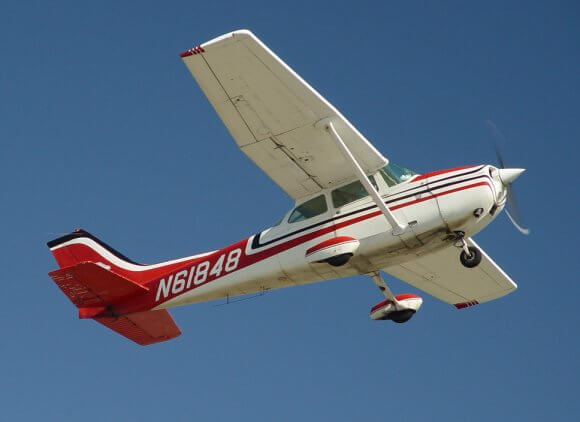
For aircraft or any object that flies at a speed below the sound barrier, the classification of subsonic applies. This category includes most commuter jets and small commercial aircraft, though some exceptions have been noted (i.e. supersonic commercial jets like the Concorde).
Since these craft never meet or exceed the speed of sound, they will have a Mach number that is less than one and therefore expressed in decimal form – i.e. less than Mach 0.8 (273 m/s; 980 km/h; 609 mph). Typically, these aircraft are propeller-driven and tend to have high aspect-ratio (slender) wings and rounded features.
The designation of transonic applies to a condition of flight where a range of airflow velocities exist around and past the aircraft. These speeds are concurrently below, at, and above the speed of sound, ranging from Mach 0.8 to 1.2 (273-409 m/s; 980-1,470 km/h; 609-914 mph). Transonic aircraft nearly always have swept wings, causing the delay of drag-divergence, and are driven by jet engines.
The next category is supersonic aircraft. These are craft that can move beyond the compression of air that is the “sound barrier.” These craft generally have a Mach number of between 1 and 5 (410–1,702 m/s; 1,470–6,126 km/h; 915-3,806 mph). Aircraft designed to fly at supersonic speeds show large differences in their aerodynamic design because of the radical differences in the behavior of flows above Mach 1.
These include sharp edges, thin wing sections, and tail stabilizers (aka. fins) or canards (forewings) that are capable of adjusting. Craft that typically have this designation include modern fighter jets, spy planes (like the SR-71 Blackbird) and the aforementioned Concorde.
The last category is hypersonic, which applies to aircraft that can exceed the speed of Mach 5 and can achieve speeds as high as Mach 10 (1,702–3,403 m/s; 6,126–12,251 km/h; 3,806–7,680 mph). Very few aircraft can move at such speeds, and tend to be rocket-powered (like the X-15), scramjets (like the X-43, or HyperX), or spacecraft that are in the process of leaving Earth’s atmosphere.
Another example is objects entering the Earth’s atmosphere. These can take the form of spacecraft performing re-entry, or meteorites that have passed through and broken up in Earth’s atmosphere. For example, the meteor that entered the skies above the above the small town of Chelyabinsk, Russia, in February of 2013 was traveling at a speed of about 19.16 ± 0.15 km/s (68,436 – 69,516 km/h; 42,524 – 43,195 mph).
In other words, the meteorite was traveling between Mach 55 and 56 when it hit our atmosphere! Given its tremendous speed, when the meteor reached the skies above Chelyabinsk, it created a sonic boom so powerful that it caused extensive damage to thousand of building in six cities across the region. This damage, which included a lot of exploding windows, resulted in 1,500 people being injured.
So how fast is Mach One? The short answer is that it depends on where you are. But in general, it is a speed that exceeds about 1200 km/h or 750 mph. If you’re capable of going this fast, you will be breaking the sound barrier, and people for miles around will be hearing about it!
We have written many interesting articles about sound here Universe Today. Here’s What is Sound?, What is the Fastest Jet in the World?, What is Air Resistance?, and What Does NASA Sound Like?
For more information, check out NASA’s Article about the Mach Number, and here’s a link to a lesson about the Mach Number.
We’ve recorded an episode of Astronomy Cast all about the space shuttle. Listen here, Episode 127: The US Space Shuttle.
Sources:
What Is Air Resistance?
Here on Earth, we tend to take air resistance (aka. “drag”) for granted. We just assume that when we throw a ball, launch an aircraft, deorbit a spacecraft, or fire a bullet from a gun, that the act of it traveling through our atmosphere will naturally slow it down. But what is the reason for this? Just how is air able to slow an object down, whether it is in free-fall or in flight?
Because of our reliance on air travel, our enthusiasm for space exploration, and our love of sports and making things airborne (including ourselves), understanding air resistance is key to understanding physics, and an integral part of many scientific disciplines. As part of the subdiscipline known as fluid dynamics, it applies to fields of aerodynamics, hydrodynamics, astrophysics, and nuclear physics (to name a few).
Definition:
By definition, air resistance describes the forces that are in opposition to the relative motion of an object as it passes through the air. These drag forces act opposite to the oncoming flow velocity, thus slowing the object down. Unlike other resistance forces, drag depends directly on velocity, since it is the component of the net aerodynamic force acting opposite to the direction of the movement.
Another way to put it would be to say that air resistance is the result of collisions of the object’s leading surface with air molecules. It can therefore be said that the two most common factors that have a direct effect upon the amount of air resistance are the speed of the object and the cross-sectional area of the object. Ergo, both increased speeds and cross-sectional areas will result in an increased amount of air resistance.

In terms of aerodynamics and flight, drag refers to both the forces acting opposite of thrust, as well as the forces working perpendicular to it (i.e. lift). In astrodynamics, atmospheric drag is both a positive and a negative force depending on the situation. It is both a drain on fuel and efficiency during lift-off and a fuel savings when a spacecraft is returning to Earth from orbit.
Calculating Air Resistance:
Air resistance is usually calculated using the “drag equation”, which determines the force experienced by an object moving through a fluid or gas at relatively large velocity. This can be expressed mathematically as:

In this equation, FD represents the drag force, p is the density of the fluid, v is the speed of the object relative to sound, A is the cross-section area, and CD is the the drag coefficient. The result is what is called “quadratic drag”. Once this is determined, calculating the amount of power needed to overcome the drag involves a similar process, which can be expressed mathematically as:

Here, Pd is the power needed to overcome the force of drag, Fd is the drag force, v is the velocity, p is the density of the fluid, v is the speed of the object relative to sound, A is the cross-section area, and Cd is the the drag coefficient. As it shows, power needs are the cube of the velocity, so if it takes 10 horsepower to go 80 kph, it will take 80 horsepower to go 160 kph. In short, a doubling of speed requires an application of eight times the amount of power.

Types of Air Resistance:
There are three main types of drag in aerodynamics – Lift Induced, Parasitic, and Wave. Each affects an objects ability to stay aloft as well as the power and fuel needed to keep it there. Lift induced (or just induced) drag occurs as the result of the creation of lift on a three-dimensional lifting body (wing or fuselage). It has two primary components: vortex drag and lift-induced viscous drag.
The vortices derive from the turbulent mixing of air of varying pressure on the upper and lower surfaces of the body. These are needed to create lift. As the lift increases, so does the lift-induced drag. For an aircraft this means that as the angle of attack and the lift coefficient increase to the point of stall, so does the lift-induced drag.
By contrast, parasitic drag is caused by moving a solid object through a fluid. This type of drag is made up of multiple components, which includes “form drag” and “skin friction drag”. In aviation, induced drag tends to be greater at lower speeds because a high angle of attack is required to maintain lift, so as speed increases this drag becomes much less, but parasitic drag increases because the fluid is flowing faster around protruding objects increasing friction. The combined overall drag curve is minimal at some airspeeds and will be at or close to its optimal efficiency.

Wave drag (compressibility drag) is created by the presence of a body moving at high speed through a compressible fluid. In aerodynamics, wave drag consists of multiple components depending on the speed regime of the flight. In transonic flight – at speeds of Mach 0.5 or greater, but still less than Mach 1.0 (aka. speed of sound) – wave drag is the result of local supersonic flow.
Supersonic flow occurs on bodies traveling well below the speed of sound, as the local speed of air on a body increases when it accelerates over the body. In short, aircraft flying at transonic speeds often incur wave drag as a result. This increases as the speed of the aircraft nears the sound barrier of Mach 1.0, before becoming a supersonic object.
In supersonic flight, wave drag is the result of oblique shockwaves formed at the leading and trailing edges of the body. In highly supersonic flows bow waves will form instead. At supersonic speeds, wave drag is commonly separated into two components, supersonic lift-dependent wave drag and supersonic volume-dependent wave drag.
Understanding the role air frictions plays with flight, knowing its mechanics, and knowing the kinds of power needed to overcome it, are all crucial when it comes to aerospace and space exploration. Knowing all this will also be critical when it comes time to explore other planets in our Solar System, and in other star systems altogether!
We have written many articles about air resistance and flight here at Universe Today. Here’s an article on What Is Terminal Velocity?, How Do Planes Fly?, What is the Coefficient of Friction?, and What is the Force of Gravity?
If you’d like more information on NASA’s aircraft programs, check out the Beginner’s Guide to Aerodynamics, and here’s a link to the Drag Equation.
We’ve also recorded many related episodes of Astronomy Cast. Listen here, Episode 102: Gravity.
Record-Setting Freefall Attempt Will be Webcast
Want to know what it is like to bail out in near space and freefall 37 km (23 miles) to Earth? You’re about to find out. While no date has been announced yet for Felix Baumgartner’s attempt at breaking the speed of sound during freefall, when it does occur, everyone will be able to watch. The Red Bull Stratos mission team announced today there will be a live television broadcast and online stream of the activities. In-flight cameras will be mounted on the capsule that brings him to 36,500 meters (120,000 feet) altitude via stratospheric balloon, as well as on Baumgartner’s space suit. If successful, this will be the first time in history a freefalling human body will reach supersonic speeds.
[/caption]
There will also be microphones inside the capsule and inside Baumgartner’s helmet. Those on the capsule will record sound only as long as there is air to carry the soundwaves. When Baumgartner depressurizes the capsule (just before he jumps), those ambient microphones in the capsule will stop picking up sound, but his helmet mic should keep working.
The final launch date, location and live stream details will be announced in the coming weeks on www.redbullstratos.com, on Twitter (@RedBullStratos), and on Facebook.
The current record-holder, USAF Col. (Ret.) Joe Kittinger jumped from 102,800 feet 50 years ago this month. He did not break the speed of sound, although he probably came close. There have been several attempts to surpass Kittinger’s record, but none have succeeded, and people have given their lives for the quest. There are some movies and images from Kittinger’s jump, and his team used spring-wound motion picture cameras warmed by hot-water bottles to document his freefall. Red Bull Stratos will use high-definition video cameras and ultra-high-definition 4K digital cinematography cameras. The challenge will be keeping them cool in an environment where the air is too thin to wick away their heat.
The footage is being taken by FlightLine Films, who will be making a documentary about the jump, so it’s not clear how much will be live on the webcast, although the press release by Red Bull Stratos says the camers will “provide viewers of the worldwide broadcast with perspectives of the capsule, the skyscape and Baumgartner himself.”
And of course there is the main reason to record everything that happens in the jump: for the benefit of scientific research.
We’ll provide an update on the date of the Baumgartner’s jump when it is announced.
Read our preview article on Baumgartner’s record-breaking attempt.
Skydiver Hopes to Break the Speed of Sound in Freefall
[/caption]
The speed of sound — historically called the ‘sound barrier’ – has been broken by rockets, various jet-powered aircraft and rocket-boosted land vehicles. Felix Baumgartner wants to break the sound barrier with his body, in freefall from the edge of space. He will travel inside a capsule with a stratospheric balloon to 36,500 meters (120,000 feet) step out and attempt a freefall jump targeted to reach – for the first time in history – supersonic speeds.
“After years of training with my team of dedicated Red Bull Stratos experts, I’ll be going on a journey that no one has ever done,” Baumgartner told Universe Today in an email message. “If I succeed, I will be the first person to break the sound barrier, alone. That will be a record for all eternity. As such, a piece of me will become immortal. That excites me.”

Back in 1960, a US Air Force captain named Joe Kittinger made aerospace history by making a jump from 31,000 meters (102,800 feet). His jump contributed valuable data that provided ground work for spacesuit technology and knowledge about human physiology for the US space program. There have been several attempts to surpass Kittinger’s record, but none have succeeded, and people have given their lives for the quest.
Sometime during 2010, Baumgartner will make an attempt in his “Red Bull Stratos” mission — named after the energy drink company that co-created the program with the Austrian skydiver. Red Bull Stratos team members say the mission will explore the limits of the human body in one of the most hostile environments known to humankind, in the attempt to deliver valuable lessons in human endurance and high-altitude technology.
“This is the biggest goal I can dream of,” Baumgartner said. “If we can prove that you can break the speed of sound and stay alive I think that is a benefit for future space exploration.”
If Baumgartner is successful, the Red Bull Stratos mission will break four world records: the altitude record for freefall, the distance record for longest freefall, the speed record for fastest freefall by breaking the speed of sound with the human body, and the altitude record for the highest manned balloon flight.

How fast will Baumgarter need to go to beat the speed of sound? Sound travels at different speeds through the atmosphere (as well as through different mediums), depending on atmospheric density and temperature. For example, at sea level, in average conditions of about 15 degrees C (59 degrees F), sound travels at around 1,223 kph (760 mph). But at higher altitudes, where the air is colder, sound travels more slowly.
Researchers with the Red Bull Stratos mission anticipate Baumgartner could break the sound barrier at about 30,480 meters (100,000 feet) above sea level, in temperatures of -23 to -40 C (-10 to -40 F) where sound travels at about 1,110 kph (690 mph) or roughly 304 meters per second (1,000 feet per second).
So, he’ll have to go faster than those speeds – or Mach 1 — to be supersonic.
While there is no literal “barrier,”the transition to supersonic speeds can cause problems for aircraft as transonic air movement creates disruptive shock waves and turbulence. Data obtained from Chuck Yeager’s first supersonic flight in 1947 allowed for changes in design of supersonic aircraft to avoid problems. Still, some aircraft still experience problems, and going supersonic has been attributed to some air disasters.
And the human body isn’t designed for supersonic speeds.
“Our biggest concern is that we don’t know how a human unencumbered by aircraft is going to transition through this,” said the project’s Medical Director Dr. Jonathan Clark, a flight surgeon for six space shuttle missions (and husband of astronaut Laurel Clark who died in the Columbia disaster in 2003), who has researched numerous aerospace disasters. “But it’s also exactly what we’re hoping to learn, for the benefit of future space flights.”
Documents provided by the Red Bull Stratos mission say that the data obtained from the mission will be shared with the scientific community, and Clark notes that he expects long-awaited medical protocols to be established as a result.
At the low temperatures and tenuous atmospheric conditions that Baumgartner will experience, he could suffer from hypothermia, the bends –if he gains altitude too fast during ascent –, or he could experience ebullism – the infamous condition where gas bubbles can form in the blood, and the blood basically “boils.”
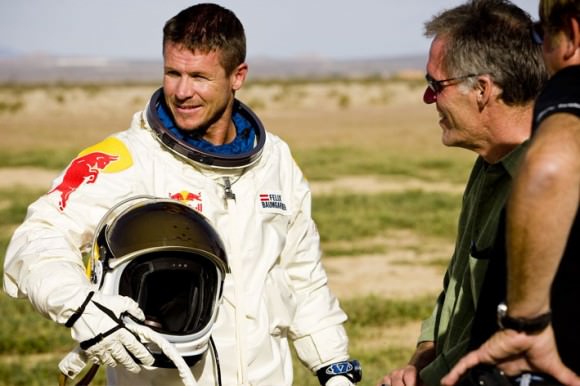
That’s why his spacesuit is so important.
“I have absolute confidence the suit is going to work,” said Daniel McCarter, Program Manager for the David Clark Company, the same company that made Kittinger’s suit back in 1960, as well as full pressure suits for NASA astronauts and military pilots flying in aircraft that can reach the edge of the atmosphere. “Every time someone jumps a suit system like this there is something to learn. We learn knowledge for future systems.”
Art Thompson, the mission’s Technical Project Director, added, “We are ultimately risking life. Felix realizes that his life is on the line. Our job is to do everything we can from an engineering and technical point of view to keep him safe.”
The suit Baumgartner will use is custom-made for him, so there should be no pressure points caused by the suit that would make him uncomfortable, but any pressure suit restricts mobility and dexterity. He will have to avoid movements that could cause him to go into an uncontrollable spin.
Baumgartner is not new to jumping. He owns several world records for B.A.S.E. jumping and is well known for skydiving across the English Channel in 2003. He is also a parachutist, stunt coordinator and a commercial helicopter pilot.
“I think I’ve always been one of those guys who wanted to be in the places where no one has been before. It’s inside your body or brain,” Baumgartner said in a video on the Red Bull Stratos website. “When I was a kid, I liked to climb up trees –I always wanted to be on top of something.”
This will definitely be an attempt to go where no one has gone before.
For more information on the mission, visit the Red Bull Stratos website, or Felix Baumgartner’s website.
What is the Fastest Jet In The World?
If you’re thinking the X-15 still holds the record for the fastest jet in the world, think again. That title is now owned by NASA’s X-43A. The unmanned aircraft hit Mach 9.6 (nearly 10 times the speed of sound) on November 16, 2004 at an altitude of 33,223 meters over the Pacific Ocean.
Of course, if you’re talking about manned flights, the X-15 with its Mach 6.72 speed is still king of the hill.
Both the X-15 and the X-43A are experimental aircrafts, designed to test new technologies and are usually associated with record-breaking feats. The X-15, for example, was specially designed to reach altitudes and speeds never achieved before.
Pilots of these planes were considered astronauts since many X-15 flights exceeded 50-mile altitudes. Many of them practically reached what is known as the Karman line a.k.a. the ‘edge of space’. That’s about 100 km above sea level.
If you’re looking for an aircraft that’s actually been put to use outside gathering experimental data, then the record holder is the SR-71 “Blackbird”. The Blackbird used to cruise at Mach 3.2 and was used primarily for reconnaissance missions.
Anyway, back to the fastest jet in the world – whether manned or unmanned.
As mentioned earlier, the X-43A, like its reputable predecessor, the X-15, is an experimental aircraft. Specifically, the the X-43 was part of the NASA Hyper-X program, a 7-yr program that cost around $230M and was launched to explore other options for space access vehicles.
At the heart of the X-43 is the scramjet or Supersonic Combustion Ramjet. You can think of it as an upgraded version of the ramjet – the kind of engine used by the SR-71. The Supersonic Combustion Ramjet basically takes in oxygen, which is needed for combustion, directly from the atmosphere. In order to create thrust, rockets mix liquid oxygen with liquid fuel.
In the usual jet plane setup, a tank of liquid oxygen has to be carried as additional load. Take that tank away, and you get a smaller, lighter plane. The added benefits are so enormous that engineers who embarked on scramjet research predicted speeds that could go up to 15 times the speed of sound.
Although the current record held by the scramjet-powered X-43A only achieved a fraction of that, Mach 9.6 is still way above what other planes have achieved.
To give you an idea how fast the fastest jet in the world is, compared to others, imagine this: there are more than 30 jets that are faster than the speed of sound and yet almost all of them have top speeds either way below or only near Mach 3. Mach 9.6 is definitely way way faster than that.
We have some articles in Universe Today that are related to this one. Here are two of them:
- X-43 Receives Guinness World Record
- Speed of Light
Related articles brought to you by NASA, here are the links:
Tired eyes? Let your ears help you learn for a change. Here are some episodes from Astronomy Cast that just might suit your taste:
- Light Speed, Andromeda Galaxy, Dark Matter and Black Holes
- Running Out of Gravitons and Hitting the Brakes at Light Speed
Source: NASA

